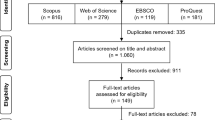Abstract
Building information modeling/management (BIM) is an emerging technological and procedural shift in the architecture, engineering, construction and operation industry. In this study, we use an extensive state-of-the-art method to clarify the BIM adoption process and the factors that can influence the success or failure of BIM adoption, particularly during the implementation stage, which are not frequently found in the literature. As an innovation, the lexical field allocated to the spread of innovations is assigned to BIM (diffusion, adoption, and implementation). After recalling the definition of relevant terms and then removing the resulting inconsistencies in vocabularies, we investigate various studies to identify factors that influence BIM adoption and then unify all these studies in one coherent and consistent BIM adoption process model. We focus on factors that play a role in the adoption of BIM in small- and medium-sized enterprises (SMEs) because SMEs constitute the majority of companies in the construction sector. This research highlights and intends to fill in some gaps found in the current BIM adoption literature.
Similar content being viewed by others
References
Abuelmaatti A A, Ahmed V S, Baban H S (2014). Collaborative technologies for small and medium-sized architecture, engineering and construction enterprises: implementation survey. Journal of Information Technology in Construction, 19: 210–224
Ahmed A L, Kassem M (2018). A unified BIM adoption taxonomy: conceptual development, empirical validation and application. Automation in Construction, 96: 103–127
Ahmed A, Kawalek P, Kassem M (2017). A conceptual model for investigating BIM adoption by organisations. In: Proceedings of the Joint Conference on Computing in Construction (JC3), Heraklion, Greece, 447–455
Al-Bahar J F, Crandall K C (1990). Systematic risk management approach for construction projects. Journal of Construction Engineering and Management, 116(3): 533–546
Aldrich H (2008). Organizations and Environments. Palo Alto, California: Stanford University Press
Arayici Y, Coates P, Koskela L, Kagioglou M, Usher C, O’reilly K (2011). Technology adoption in the BIM implementation for lean architectural practice. Automation in Construction, 20(2): 189–195
Autissier D, Vandangeon-Derumez I, Vas A (2014). Change management, key concepts: 50 years of research from major authors. Paris: Dunod (in French)
Barba-Sánchez V, Martínez-Ruiz M, Jiménez-Zarco A I (2007). Drivers, benefits and challenges of ICT adoption by small and medium sized enterprises (SMEs): a literature review. Problems and Perspectives in Management, 5(1): 103–114
Bataw A, Burrows M, Kirkham R (2014). The challenges of adopting Building Information Modelling (BIM) principles within Small to Medium sized Enterprises (SMEs). In: Proceedings of the 14th International Conference on Construction Applications of Virtual Reality (CONVR2014), Sharjah, UAE., CONVR, 318–324
Bonanomi M, Paganin G, Talamo C (2016). BIM implementation in design firms. Risk-Response Strategies to Support Change Management, 1–9
Burgelman R A, Mittman B S (1994). An intraorganizational ecological perspective on managerial risk behavior, performance, and survival: individual, organizational and environmental effects. In: Baum J, Singh J, eds. Evolutionary Dynamics in Organizations. New York: Oxford University Press
Caille E (2017). Ranking of the first 300 architecture firms in France by sales revenue. D’Architectures,166–180 (in French)
Chien K F, Wu Z H, Huang S C (2014). Identifying and assessing critical risk factors for BIM projects: empirical study. Automation in Construction, 45: 1–15
Davis F D (1989). Perceived usefulness, perceived ease of use, and user acceptance of information technology. Management Information Systems Quarterly, 13(3): 319–340
DiMaggio P J, Powell W W (1983). The iron cage revisited: institutional isomorphism and collective rationality in organizational fields. American Sociologiview, 48(2):147–160
Edwards T, Delbridge R, Munday M (2005). Understanding innovation in small and medium-sized enterprises: a process manifest. Technovation, 25(10): 1119–1127
Georgiadou M C (2016). Building Information Modelling in UK construction projects: a state of the art review. In: COBRA 2016, Toronto, Canada
Ghaffarianhoseini A, Doan D T, Zhang T, Ghaffarianhoseini A, Naismith N, Tookey J (2016). A BIM readiness & implementation strategy for SME construction companies in the UK. In: Proceedings of the 33rd CIB W78 Conference
Gledson B, Henry D, Bleanch P (2012). Does size matter? Experiences and perspectives of BIM implementation from large and SME construction contractors In: 1st UK Academic Conference on Building Information Management (BIM) 2012, Northumbria University, Newcastle upon Tyne, UK
Greenwood R, Hinings C R (1988). Organizational design types, tracks and the dynamics of strategic change. Organization Studies, 9(3): 293–316
Gu N, London K (2010). Understanding and facilitating BIM adoption in the AEC industry. Automation in Construction, 19(8): 988–999
Hannan M T, Freeman J (1977). The population ecology of organizations. American Journal of Sociology, 82(5): 929–964
Hannan M T, Freeman J (1984). Structural inertia and organizational change. A merican Sociological Review, 49(2): 149–164
Hochscheid E, Halin G (2018a). BIM implementation in architecture firms: interviews, case studies and action research used to build a method that facilitates implementation of BIM processes and tools. In: Proceedings of the 36th ECAADe Annual Conference, Lodz, Poland, 10
Hochscheid E, Halin G (2018b). A model to approach BIM adoption process and possible BIM implementation failures. In: Proceedings of the Creative Construction Conference 2018 (CCC), Ljubljana, Slovenia
Hochscheid E, Ribereau-Gayon M, Halin G, Hanser D (2016). BIM implementation in SMEs: an experience of cooperation between an architect agency and a carpentry firm. In: Proceedings of ICCCBE2016, Osaka, Japan
Holzer D (2015). The BIM Manager’s Handbook, Part 2: Change Management. New York: John Wiley & Sons
Hong Y, Sepasgozar S M, Ahmadian A F F, Akbarnezhad A (2016). Factors influencing BIM adoption in small and medium sized construction organizations. In: Proceedings of the International Symposium on Automation and Robotics in Construction, Vilnius Gediminas Technical University
Hosseini M R, Namzadi M O, Rameezdeen R, Banihashemi S, Chileshe N (2016). Barriers to BIM adoption: Perceptions from Australian small and medium-sized enterprises (SMEs). In: AUBEA 2016: Proceedings of the 40th Australasian Universities Building Education Association Annual Conference, Central Queensland University, 271–280
Hosseini R, Pärn E, Edwards D, Papadonikolaki E, Oraee M (2018) Roadmap to mature BIM use in Australian SMEs: competitive dynamics perspective. Journal of Management Engineering, 34(5): 05018008
Insee (2015). The national institute of statistics and economic studies collects, analyses and disseminates information on the French economy and society, Construction sector-Companies in France. Insee References (in French), free access in Insee website
Insee (2016). The national institute of statistics and economic studies collects, Decree n°2008–1354 article 3. Definition of Enterprise Categories (in French), free access in Insee website
Insee (2017). The national institute of statistics and economic studies collects, analyses and disseminates information on the French economy and society, economic outlook. Insee References (in French), free access in Insee website
Karlsson C (1988). Innovation adoption and the product life cycle. Dissertation for the Doctoral Degree. Umeå: Umeå a Universitet
Kassem M, Succar B (2017). Macro BIM adoption: comparative market analysis. Automation in Construction, 81: 286–299
Klein K J, Sorra J S (1996). The challenge of innovation implementation. Academy of Management Review, 21(4): 1055–1080
Kotter J P, Cohen D S (2002). The Heart of Change: Real-Life Stories of How People Change Their Organizations. Boston: Harvard Business School Press
Kouider T, Paterson J J G (2014). Architectural technology and the BIM acronym: 2. Reviewing evolving paradigms for BIM implementation among SMEs. In: Architectural Technology, Towards Innovative Professional Practice: Conference Proceedings of the 5th International Congress of Architectural Technology, Aberdeen 2014 (ICAT2014), Robert Gordon University
Laforet S (2013). Organizational innovation outcomes in SMEs: effects of age, size, and sector. Journal of World Business, 48(4): 490–502
Lines B C, Sullivan K T, Smithwick J B, Mischung J (2015). Overcoming resistance to change in engineering and construction: change management factors for owner organizations. International Journal of Project Management, 33(5): 1170–1179
Machado M, Underwood J, Fleming A J (2016). Implementing BIM to streamline a design, manufacture, and fitting workflow: a case study on a fit-out SME in the UK. International Journal of 3-D Information Modeling, 5(3): 31–46
Malleson A, Kato H, Popíšilová B, Watson D, Friborg G (2016). NBS International BIM Report 2016. NBS Report
McGraw Hill Construction (2010). The business value of BIM in Europe: getting building information modelling to the bottom line the United Kingdom, France and Germany
McGraw Hill Construction (2014). The business value of BIM for construction in major global markets: how contractors around the world are driving innovations with Building Information Modelling. Smart Mark
Mintzberg H, Westley F (1992). Cycles of organizational change. Strategic Management Journal, 13(S2): 39–59
Murguia S D E, Demian P, Soetanto R (2017). A systemic BIM innovation model in the construction supply chain. In: Proceedings of the 33rd Annual ARCOM Conference, Cambridge, UK 15–24
Pettigrew A M (1987). Context and action in the transformation of the firm. Journal of Management Studies, 24(6): 649–670
Poirier E, Staub-French S, Forgues D (2015). Embedded contexts of innovation: BIM adoption and implementation for a specialty contracting SME. Construction Innovation, 15(1): 42–65
PTNB (2017). Barometer-BIM in the construction sector. PTNB (in French)
Rogers E M (2003). Diffusion of Innovations. 5th ed. New York: Simon and Schuster
Sainsaulieu R, Segrestin D (1986). Towards a sociological theory of business. Sociology of Labor, 28(3): 335–352 (in French)
Singh J V, House R J, Tucker D J (1986). Organizational change and organizational mortality. Administrative Science Quarterly, 31(4): 587–611
Smith P (2014). BIM Implementation—Global Strategies. Procedia Engineering, 85, 482–492
Stoneman P, Diederen P (1994). Technology diffusion and public policy. Economic Journal (London), 104(425): 918–930
Succar B (2009). Building information modelling framework: a research and delivery foundation for industry stakeholders. Automation in Construction, 18(3): 357–375
Succar B, Kassem M 2015. Macro-BIM adoption: conceptual structures. Automation in Construction, 57: 64–79
Tétard F, Collan M (2009). Lazy user theory: a dynamic model to understand user selection of products and services. In: 2009 42nd Hawaii International Conference on System Sciences, IEEE Conferences, 1–9
Turk Z (2000). Construction IT: definition, framework and research issues. In: Fischiner M, ed. Faculty of Civil and Geodetic Engineering on the Doorstep of the Millennium: On the Occasion of Its 80th Anniversary, 17–32
Venkatesh V, Davis F D (2000). A theoretical extension of the technology acceptance model: four longitudinal field studies. Management Science, 46(2): 186–204
Waarts E, van Everdingen Y M, van Hillegersberg J (2002). The dynamics of factors affecting the adoption of innovations. Journal of Product Innovation Management, 19(6): 412–423
Waterhouse R, Parkinson K, Malleson A (2017). National BIM Report 2017. NBS Report
Winch G, McDonald J (1999). SMEs in an environment of change: computer-based tools to aid learning and change management. Industrial and Commercial Training, 31(2): 49–56
Author information
Authors and Affiliations
Corresponding author
Rights and permissions
About this article
Cite this article
Hochscheid, E., Halin, G. Generic and SME-specific factors that influence the BIM adoption process: an overview that highlights gaps in the literature. Front. Eng. Manag. 7, 119–130 (2020). https://doi.org/10.1007/s42524-019-0043-2
Received:
Accepted:
Published:
Issue Date:
DOI: https://doi.org/10.1007/s42524-019-0043-2




